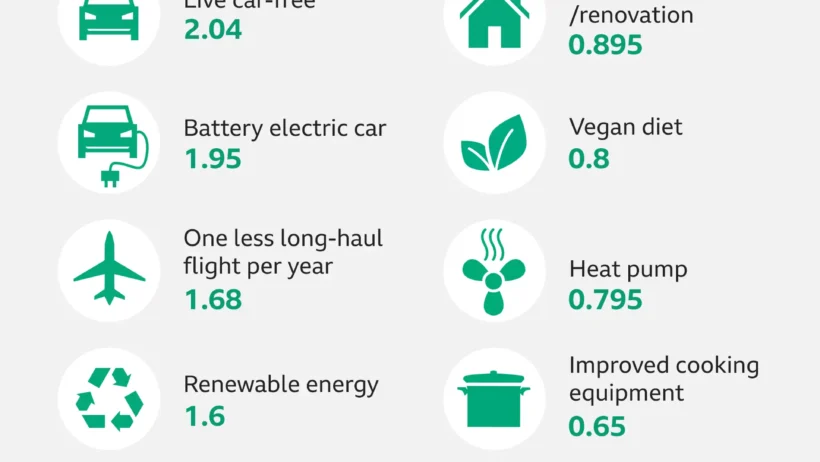Climate change presents one of the most profound challenges of our time. The increasing frequency of extreme weather events, rising sea levels, and disruptions to ecosystems underscore the urgency for action. Individuals, communities, and governments alike must grapple with the implications of climate change, yet many are unsure how they can contribute to mitigating its effects. This article aims to elucidate actionable strategies that not only make a difference but also engender a profound sense of collective responsibility.
Understanding Our Carbon Footprint
Before delving into actionable steps, it is crucial to comprehend what a carbon footprint is. Essentially, it refers to the total amount of greenhouse gases, primarily carbon dioxide, that are emitted directly or indirectly by an individual, organization, event, or product. Each decision made on a daily basis—ranging from transportation and energy consumption to food choices—contributes to this footprint.
To reduce climate change, one needs to first assess their personal or household carbon footprint. Tools available online can assist in estimating this footprint by accounting for various factors such as travel routines, lifestyle choices, and dietary habits. With this knowledge in hand, actionable steps can be taken to lower it.
Transforming Transportation Habits
Transportation is a paramount contributor to greenhouse gas emissions, representing a significant portion of the carbon footprint for many individuals. Changes in transportation habits can have a substantial impact.
Consider adopting public transportation systems that utilize cleaner technologies, such as electric buses or trains, to decrease reliance on personal vehicles. In urban settings, cycling or walking not only reduces emissions but also promotes physical health. For those who must drive, opting for fuel-efficient or electric vehicles can lead to significant reductions in carbon output.
Additionally, carpooling is an effective way to minimize emissions while enhancing community connections. By sharing rides, individuals can significantly reduce the number of vehicles on the road, ultimately leading to fewer emissions and decreased traffic congestion.
Energy Consumption: The Home Front
Your home is a perennial source of carbon emissions, primarily through the energy used for heating, cooling, and powering appliances. Making conscientious choices can drastically reduce your home’s carbon footprint.
Start with energy-efficient appliances that consume less electricity, thus minimizing emissions associated with energy production. Look for the Energy Star label when purchasing new products, which indicates compliance with energy efficiency guidelines.
Moreover, consider conducting an energy audit. This assessment can identify areas where improvements can be made, such as enhancing insulation, sealing gaps, and upgrading windows and doors. By reducing energy consumption, not only do homeowners cut down their emissions, but they also save money on energy bills over time.
Incorporating renewable energy sources, such as solar panels, can also serve as a formidable solution. While initial costs may seem prohibitive, government incentives and tax credits can mitigate financial burdens. Moreover, the long-term benefits of harnessing renewable energy—sustainability and reduced reliance on fossil fuels—far outweigh short-term investments.
Mindful Consumption and Sustainable Food Choices
The choices made at the grocery store or restaurant significantly influence carbon emissions. The production, transportation, and disposal of food all contribute to your overall carbon footprint.
Embrace a plant-based diet, as animal agriculture is a major driver of greenhouse gas emissions. Incorporating more fruits, vegetables, legumes, and grains can lead to lower emissions while also promoting better health.
Prioritize local and seasonal foods. By opting for locally sourced products, consumers can reduce emissions tied to the transportation of goods. Furthermore, supporting local farmers fosters community resilience and helps maintain agricultural diversity.
Be vigilant in reducing food waste, which is another significant contributor to carbon emissions. Plan meals ahead, use leftovers creatively, and compost when possible. By rethinking food waste, individuals can conserve resources and diminish the carbon footprint associated with producing unnecessary food.
Advocacy and Community Engagement
While individual actions hold weight, collective action amplifies impact. Engaging in community discussions about climate issues raises awareness and forms networks of support. Join local environmental organizations or initiatives that resonate with your values. Collaborating with others can lead to significant changes in policies and perceptions surrounding climate change.
Advocacy extends to contacting local representatives to demand policy changes that promote sustainability and address climate issues. Support legislation that encourages renewable energy development, carbon pricing, and sustainable agricultural practices. Your voice matters—demanding accountability and progress from leaders fosters a climate-conscious society.
Education is paramount. Share knowledge regarding climate change and its impacts. Host workshops or utilize social media platforms to disseminate information, encouraging conversations that inspire positive change within your community.
Conclusion: Every Action Counts
The fight against climate change is ongoing, yet every action has the potential to contribute to a more sustainable future. From examining transportation habits to reducing energy consumption and sustainable food choices, small changes can accumulate to create a significant impact.
By fostering awareness, engaging in community advocacy, and committing to individual actions, everyone can play a role in combating climate change. The path may be challenging, but through unified efforts, there is hope for a healthier, sustainable planet for future generations.







